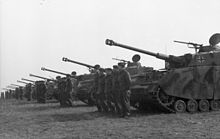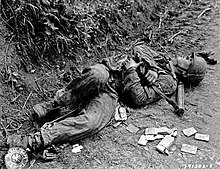12th SS Panzer Division Hitlerjugend
| SS Division Hitlerjugend | |
|---|---|
| 12. SS-Panzerdivision "Hitlerjugend" | |
Panzer | |
| Role | Armoured warfare |
| Size | Division |
| Part of | I SS Panzer Corps |
| Patron | Artur Axmann |
| Commanders | |
| Notable commanders | |
The SS Division Hitlerjugend or 12th SS Panzer Division "Hitlerjugend" (German: 12. SS-Panzerdivision "Hitlerjugend") was a German armoured division of the Waffen-SS during World War II.[1] The majority of its junior enlisted men were drawn from members of the Hitler Youth, while the senior NCOs and officers were from other Waffen-SS divisions.
The division committed several
In December 1944, the division was committed against the US Army in the
Formation and training
The idea for the Waffen-SS division was first proposed by Artur Axmann, the leader of the Hitler Youth, to Reichsführer-SS Heinrich Himmler in early 1943.[3] The plan for a division made up of Hitler Youth members born in 1926 was passed on to Adolf Hitler for his approval. Hitler approved the plan in February and SS-Gruppenführer Gottlob Berger was ordered to recruit the personnel.[3] SS-Oberführer Fritz Witt of 1st SS Panzer Division Leibstandarte SS Adolf Hitler (LSSAH) was appointed the divisional commander.[3] Personnel from the LSSAH provided the regimental, battalion and most of the company commanders for the division.[4]

About 2,000 personnel were transferred from the LSSAH and in September 1943, the division had over 16,000 recruits on its roster, undergoing training in Beverloo Camp in Leopoldsburg, Belgium.[3] The indoctrination was often brutal; while in Allied captivity, an SS man from the division recalled: "In the Waffen-SS you couldn't do anything if an Unterfuhrer hit you during the training. The purpose of the training is to make you just as they are; it's pure sadism". (The comments have also been taken from similar transcripts).[5]
In March 1944 the 12th SS was attached to the I SS Panzer Corps and transferred to Caen in Normandy.[6] At the beginning of June, the division had over 150 tanks.
Ascq massacre
The division committed its first massacre while en route to Normandy. The division executed 86 French men on 1 April 1944 in Ascq, France, in a reprisal against the civilian population after the railway they were on was sabotaged. The commander of the convoy, SS-Obersturmführer Walter Hauck, ordered troops to search and arrest all male members of the houses on both sides of the track. Altogether, 70 men were shot beside the railway line and another 16 killed in the village. In 1949, Hauck was put on trial in Lille, France, and was sentenced to death. His sentence was later commuted to life imprisonment. He was freed in 1957 after a further sentence reduction.
Normandy

On 6 June 1944, the division, along with the
The division's advance to the areas near the British–Canadian landing beaches of


At 10:00 hours on 7 June, the 25th SS Panzergrenadier Regiment, along with 50 Panzer IV tanks of the 12th SS Panzer Regiment, arrived and moved into position north-west of Caen.[10] Supported by a battalion of artillery (3rd Battalion, 12th SS Panzer Regiment), this battle group was ordered to stop the Canadian advance and drive through to the coast, a few kilometres away.[11] They failed to break through the Canadians around Buron, a kilometre to the north. Meyer countermanded the divisional commander's order on his own initiative, feeling that objective unrealistic and hoped merely to stop the flow of Canadian units inland until the situation could be stabilized.[12]
The attack by the division was supposed to have been supported by the 21st Panzer Division but they could not disengage from fighting the British
The attack at 03:30 hours on 8 June had little initial success. The various companies in the attacking battalion failed to coordinate effectively and suffered many casualties. Facing Canadian artillery and the supporting heavy machine guns of the
On the Canadian right, the 2nd Battalion attacked the
The 3rd Canadian Division ceased major combat operations until July, with only one day of major operations, on 11 June, at the

During Charnwood, the division was driven from its positions in Buron and nearby villages of Gruchy and Cussy and the divisional command post in the Ardenne Abbey, which had been occupied since before D-Day, was lost.
During their retreat from France, members of the LSSAH and the Hitlerjugend division murdered 34 French civilians in the towns of
Ardenne Abbey massacre

Another massacre was committed by the division on its second day of operations during
Ardennes offensive

In September, SS-Obersturmbannführer
1945
On 14 January 1945, Dietrich's
Organization
The organization structure of this SS
| Designation (English)[35] | Designation (German)[36] |
|---|---|
|
Commanders
| No. | Portrait | Commander | Took office | Left office | Time in office |
|---|---|---|---|---|---|
| 1 | SS-Brigadeführer Fritz Witt (1908–1944) | 24 June 1943 | 14 June 1944 † | 356 days | |
| 2 | SS-Oberführer Kurt Meyer (1910–1961) | 16 June 1944 | 6 September 1944 | 82 days | |
| - | SS-Sturmbannführer Hubert Meyer (1913–2012) Acting | 6 September 1944 | 24 October 1944 | 48 days | |
| 3 | SS-Brigadeführer Fritz Kraemer (1900–1959) | 24 October 1944 | 13 November 1944 | 20 days | |
| 4 | SS-Standartenführer Hugo Kraas (1911–1980) | 13 November 1944 | 8 May 1945 | 176 days |
See also
References
Citations
- ^ Official designation in German language as to "Bundesarchiv-Militärarchiv" in Freiburg im Breisgau, stores of the Wehrmacht and Waffen-SS.
- ^ National Geographic, "Hitler's teen killers", 2021, https://www.natgeotv.com/za/shows/natgeo/hitlers-teen-killers
- ^ a b c d McNab 2013, p. 295.
- ^ Reynolds, Michael (2008). Steel Inferno. Spellmount Publishing. pp. 10–11.
- ^ Neitzel & Welzer 2012, p. 313.
- ^ Reynolds, Michael (2008). Steel Inferno. Spellmount Publishing. p. 16.
- ^ Barbier, p. 113.
- ^ Milner, p. 129.
- ^ Milner, p. 130.
- ^ Stacey, C. P. (1960). The Victory Campaign. Official History of the Canadian Army in the Second World War. Vol. III. Ottawa: The Queen's Printer and Controller of Stationery. p. 130.
- ^ a b Stacey, op. cit., p. 137 and Haller, Oliver: "The Defeat of the 12th SS 7–10 June 1944", in Canadian Military History Quarterly, Volume 3, Issue 1 Available online Archived 27 March 2009 at the Wayback Machine. Accessed 6 April 2009. Archived 30 April 2009.
- ^ Stacey, ibid. Stacey notes that Meyer's own notes were not explicit on this point.
- ^ Haller, The defeat of the 12th SS from 7–10 June 1944 (From: Canadian Military History, Spring 1996)
- ^ Copp, Fields of Fire: The Canadians in Normandy, p. 67.
- ^ Stacey, C.P. The Official History of the Canadian Army in the Second World War Volume 3: The Victory Campaign
- ^ Stacey, C. P. (1959). Official History of the Canadian Army in the Second World War Volume III. Queen's Printer. p. 279.
- ISBN 1-55365-102-2.
- ^ Haller, Oliver. Defeat of the 12th SS.
- ^ Martin, Charles Cromwell Battle Diary See also Stacey, op. cit.
- ^ Battle of Caen: The Stalingrad of the Hitler Youth by Gerhard Rempel
- ^ Stacey, Charles Perry (1960). Vol. III - The Victory Campaign (PDF). Official History of the Canadian Army in the Second World War. Ottawa: The Queen's Printer and Controller of Stationery. p. 161. Archived from the original (PDF) on 21 December 2020. Retrieved 23 October 2015.
- ^ Forty 2004, p. 29.
- ISBN 978-0-14-311818-3.
- ^ Meyer, Hubert (2005). The 12th SS: The History of the Hitler Youth Panzer Division Volume 2. Stackpole Books. p. 171.
- ^ Zetterling 2019, pp. 315, 316.
- ^ Stein 1984, pp. 226, 227.
- ^ Priestman, Karen (2003). The Kurt Meyer Case: The Press and the Canadian People's Response to Canada's First War Crimes Trial. Wilfrid Laurier University Press, pp. 22, 24.
- ^ Meyer, Kurt (2001). Grenadiers. JJ Fedorowicz Publishing LTD. p. 237.
- ^ Mitchum, Samuel (2006). Panzers in Winter; Hitlers Army and the Battle of the Bulge. Greenwood Publishing group. p. 158.
- ^ Mitchum, Samuel (2006). Panzers in Winter; Hitler's Army and the Battle of the Bulge. Greenwood. p. 160.
- ^ Stein 1984, p. 238.
- ^ Dollinger 1967, p. 198.
- ^ McNab 2009, p. 182.
- ^ GORDON WILLIAMSON: "The SS Hitler's Instrument of the power"; published by KAISER; appendix, page 244, "Schlachtordnung der Waffen-SS / Waffen-SS order of battle"; copyright 1994 by Brown Packaging Books Ltd., London.
- ^ MILITÄRISCHES STUDIENGLOSAR ENGLISCH Teil II/ Teil III, Deutsch – Englisch, Abkürzung Begriff, Bundessprachenamt (Stand Januar 2001).
- ^ Official designation as to "Bundesarchiv-Militärarchiv" in Freiburg im Breisgau, stores of the Wehrmacht and Waffen-SS.
Bibliography
- Barbier, Mary (2007). D-day Deception: Operation Fortitude and the Normandy Invasion. Greenwood Publishing Group. ISBN 978-0-275-99479-2.
- Dollinger, Hans (1967) [1965]. The Decline and Fall of Nazi Germany and Imperial Japan. New York: Bonanza Books. ISBN 978-0517013137.
- Forty, George (2004). Villers Bocage. Battle Zone Normandy. ISBN 0-7509-3012-8.
- McNab, Chris (2009). The SS: 1923–1945. Amber Books Ltd. ISBN 978-1-906626-49-5.
- McNab, Chris (2013). Hitler's Elite: The SS 1939-45. Osprey Publishing. ISBN 978-1782000884.
- Meyer Kurt, Grenadiers, ISBN 0-921991-59-2
- Meyer Hubert, The 12th SS: The History of the Hitler Youth Panzer Division, Stackpole Books, 2005, ISBN 0-8117-3198-7
- Meyer Hubert, The 12th SS Volume Two: The History of the Hitler Youth Panzer Division, Stackpole Books, 2005, ISBN 0-8117-3199-5
- Milner, Marc (2014). Stopping the Panzers. University Press of Kansas. ISBN 978-0700620036.
- Mitcham Samuel W, Panzers in Winter: Hitler's Army and the Battle of the Bulge, Greenwood Publishing Group, 2006, ISBN 0-275-97115-5
- ISBN 978-1-84983-949-5.
- Reynolds Michael, Steel Inferno, Spellmount Publishing, 2008, ISBN 978-1-86227-410-5
- Stein, George (1984) [1966]. The Waffen-SS: Hitler's Elite Guard at War 1939–1945. Cornell University Press. ISBN 0-8014-9275-0.
- Zetterling, Niklas (2019). Normandy, 1944: German Military Organization, Combat Power and Organizational Effectiveness. Philadelphia, Pennsylvania: ISBN 978-1612008165.
Further reading
- Gullachsen, Arthur (2021). "The Night of the Panthers: The Assault of Kampfgruppe Meyer/Wünsche on Bretteville-l'Orgueilleuse, 8/9 June 1944". Canadian Military History. 30 (1): 1–38. ISSN 1929-400X. Retrieved 25 April 2024.





